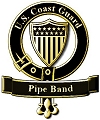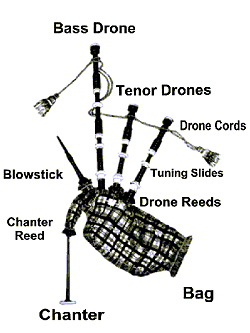 Parts of the Bagpipe
Parts of the Bagpipe
For additional FAQs and info, also see:
-- Drum FAQs
-- Pipes FAQ
-- FAQs

Blowstick
The player fills the bag (with air from his lungs) using the blow stick like a mouthpiece. This attaches to the bag. There is also a valve inside that keeps the air flowing into the bag (and not back out). The player must continuously fill the bag to sound the pipes. This takes a tremendous amount of physical endurance.
Bass Drone
The drones are responsible for the characteristic low "humming" sound that emanates from the pipes. The bass drone produces a tone that is one octave below that of the tenor drones, filling out the sound.
Tenor Drones
The drones are responsible for the "humming" sound that emanates from the pipes. The two tenor drones are tuned one octave above the bass drone. The sound travels out through the top of the drones (over the player's shoulder).
Bag
The bag is a bladder that is continuously filled with air (from the blowstick). Once the bag is filled, the player must squeeze air out of the bag (using his arm). This pushes the air through the chanter and drone reeds to make a sound. Originally made of sheepskin or cowhide, pipe bags are now made of synthetic materials that are always airtight. Constant and steady pressure must be applied to the bag (using the player's arm) in order to maintain a steady tone from the drones. This takes a tremendous amount of control and physical endurance.
Chanter Reed
The chanter reed, made of two tightly woven bamboo slivers, is hidden inside the pipes, between the bag and the chanter. Air is pushed from the bag through the reed, producing the sound for the chanter notes.
Pipe Chanter
The chanter is the part of the pipes that actually produces melody notes. The player holds the chanter vertically and "fingers" the chanter similar to a clarinet. Covering up or uncovering a hole with a finger produces a different note. There are only eight holes and nine notes on the chanter, but the highly intricate finger movements take a great amount of technique and manual dexterity.
Drone Cords
These are fancy, woven cords that are tied around the shaft of each drone. Though they look nice and often match the bag cover or uniform, the drone cords allow the drones to hang a certain distance apart from each other, while staying together.
Tuning Slide
By shortening or elongating the length, the player finds the desired note and tunes drones. Parts of the tuning slides are often ornamented with silver, ivory or other materials, though these are only decorative and do not change the sound of the pipes.
Drone Reeds
Each drone has one long reed inside of it, at the base. It is inserted into the base of the drone, between the bag and the drone itself. Acting as an airflow valve, it allows air to be pushed through into the body of the drone, producing the low humming sound. Originally made of bamboo stalks, many players now use drone reeds made of synthetic materials that are not as easily affected by changes in humidity
U.S. Coast Guard Pipe Band, Inc.
290 NW Peacock Blvd #881316
Port Saint Lucie , Florida 34988


